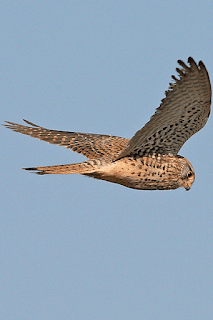Birds in Spain – Andalucia - Rüppell's Vulture
Species: Rüppell's Vulture – Gyps rueppellii – Buitre Moteado
 |
| Rüppell's Vulture juvenile note dark neck and head |
Polytypic. Nominate rueppellii, Sahel zone south of Sahara from Sénégal east to Sudan and south to East Africa, straggler Egypt. Extralimital: erlangeri, Ethiopia and Somalia.
Rare visitor. Although a rare visitor, this species has, in recent times, become more commonly (annually) reported, especially in the area close to the Strait of Gibraltar. It is impossible to be clear on how many birds visit each year, due to lack of observer coverage. However, as recently as 2010, a brave attempt at an estimate puts the number at 8 or more individuals. Reports also have been made of an adult and juveniles being present throughout the year. Like many unusual bird sightings, the lack of coverage and people being on the lookout for the unexpected, has probably led to these vultures being overlooked. Here we give an identification aid, which we hope will assist the resident and visiting birder. See author’s note.
Especie: Buitre Moteado - Gyps rueppellii - Rüppell's Vulture
Politípica. Nomina rueppellii, al sur del Sahel zona del Sahara desde el este de Sudán, Senegal y el sur de África oriental, rezagado Egipto. Extralimite: erlangeri, Etiopía y Somalia.
 |
| Figure 1. Rüppell's left Griffon right |
Un raro visitante. A pesar de un visitante poco común, esta especie tiene, en los últimos tiempos, cada vez más frecuentemente (cada año) informó, especialmente en el área cercana al Estrecho de Gibraltar. Es imposible tener claro cómo las aves que visitan cada año, debido a la falta de cobertura de los observadores. Sin embargo, tan recientemente como 2010, un valiente intento de una estimación pone el número a las 8 o más personas. En los informes también se han hecho de un adulto y los menores están presentes todo el año. Al igual que muchos avistamientos de aves inusuales, la falta de cobertura y la gente está en busca de lo inesperado, probablemente ha llevado a estos buitres que se pasa por alto. Aquí le damos una ayuda de identificación, que esperamos que ayuden al observador de aves residentes y visitantes. Véase la nota del autor.
Author’s note:
 |
| Figure 2. Rüppell's left Griffon right |
A watchful eye cast upon groups of the resident and very numerous Griffon Vulture Gyps fulvus can and does have its rewards. It is easy to dismiss any large brown vulture as being G.fulvus, but it is necessary to pay more attention to these large vultures to give yourself a better chance of spotting the elusive Rüppell's. In typical flight, the action is similar to G. fulvus but lighter, with an easier take-off. Flight silhouette is also similar to G. fulvus, but soars and glides on level wings unlike that species. Both the adult and the immature are unmistakable, when barred under wing-coverts and/or scaled pattern of the upperwing visible, see underwing photograph to the left Figure 1 and upperwing photograph Figure 2. The breast feathers are scaled and not streaked as in G.fulvus, see breast photograph Figure 3. The head and neck of the juvenile is always dark and lacks extensive collar, see photograph at the start of this article.
Nota del autor:
 |
| Figure 3. Rüppell's left Griffon right |
Un elenco atenta mirada a los grupos del residente y muy numerosos Buitre leonado Gyps fulvus puede tener y tiene sus recompensas. Es fácil despedir a un buitre marrón grande como G.fulvus, pero es necesario prestar más atención a estos grandes buitres para darse una mejor oportunidad de detectar el elusivo moteado. En vuelo normal, la acción es similar a G.fulvus pero más ligero, con un fácil despegue. silueta de vuelo es también similar a G.fulvus, pero se eleva y se desliza en las alas de nivel a diferencia de esa especie. Tanto los adultos e inmaduros son inconfundibles, cuando se prohibió bajo el ala-coberteras y / o modelo a escala de la fotografía alares visibles, ver fotografía inferior de las alas a la izquierda Figura 1 y Figura 2 alares. Las plumas del pecho y no se escalan rayas como en G.fulvus, vea mama fotografía Figura 3. La cabeza y el cuello del menor es siempre oscuro y carece de cuello amplio, véase la fotografía al inicio de este artículo.
Distribution of G.rueppellii in Andalusia
Distribución de G.rueppellii en Andalucía





Comments